2024 Лучшие бесплатные Deepnude AI: AI обнаженные
Ниже представлен список лучших AI-приложений для создания ню, которые стоит проверить!

Computer-generated imagery has made astounding strides in the quickly developing field of artificial intelligence. Now that generative models are available, it is possible to use AI to create exceptional artwork from regular photos. This marriage of cutting-edge technology and artistic expression offers a world of possibilities for designers, artists, and fans alike.
This essay will explore the intriguing field of creating AI images from photos and offer a thorough how-to for newcomers and seasoned practitioners. We'll review the fundamental ideas behind generative models, the necessary tools and methods, and step-by-step directions for starting this creative endeavor.
Prepare to revolutionize your approach to visual creativity as you unleash the full potential of generative models.
By the time you finish reading this article, you'll not only be equipped with the knowledge necessary to start working on your own AI image generation projects, but you'll also have a better understanding of how technology and creativity can coexist. Let's begin this fascinating exploration of the world of AI-powered imagery.
AI image generators are computer programs or systems powered by artificial intelligence algorithms that can produce new images based on existing data. They use cutting-edge machine-learning techniques to generate visuals that frequently mimic the provided input's style, content, or characteristics. AI image generators have a wide range of applications. They can be used in art and digital media to produce distinctive visuals, in video games to create realistic environments, and in many other fields.
AI image generators commonly employ neural network models designed to interpret and translate text inputs into corresponding visual outputs. These neural networks undergo extensive training on extensive datasets containing pairs of images and accompanying text descriptions. This training process refines the AI's ability to create coherent, contextually accurate images that are visually appealing in response to textual prompts.
An illustrative example of such technology is Midjourney. This sophisticated system relies on advanced artificial neural networks to comprehend textual instructions and generate high-resolution, accurate images based on the provided descriptions.
It is simple to create AI images from photos using AI image generators. Follow the below-listed steps to use AI image generators from photos.
Choosing the right AI image-generation platform necessitates thorough research. Start by assessing the various options in the market. Scrutinize user feedback and industry analyses to pinpoint a venue that matches your particular requirements and goals.
In the process of investigating and deciding on a platform for AI image generation, take into account the following elements to guarantee that the AI image generator suits your distinct needs and anticipations:
● Ease of use
● Cost
● Quotas and usage limits
● Support and community
● Scalability
● Reviews and testimonials
● Security and compliance
● Legal and licensing issues
By followinga few key steps,remarkable results can be achieved:
● First and foremost, the choice of the source image plays a pivotal role. High- resolution, clear photos provide a solid foundation for the AI model to work with. This ensures that the generated image retains essential details and produces a visuallypleasing result.
● Experimentation with different AI models and algorithms is crucial. Each model brings its own strengths and styles to the table. Some excel in realistic rendering, while others offer stylized or abstract interpretations. This diversity allows for a wide range of creative possibilities.
● Fine-tuning the output is another crucialstep. Adjusting parameters such as brightness, contrast, saturation, and applying different styles can significantly impact the final image. This process allows for customization and tailoring to specific artistic visions.
● Iteration is key to refining the generated image. Multiple versions can be created and refined until the desired outcome is achieved. This iterative approach ensures that the final image meets the creator's expectations and vision.
● Providing clear instructions to the AI model, if possible, is a powerful tool. This helps guide the AI towards specific focal points, styles, or features, aligning the generated image more closelywith the creator's intent.
● Lastly, considering per-processing of the source image can be beneficial. This might involve adjustments in colors, cropping, or enhancing specific features to further guide the AI towards the desired outcome.
With its user-friendly interface and cutting-edge AI technology, PhotoDirector is the ultimate photo editing application, giving you a smooth and straightforward experience. PhotoDirector caters to professional users seeking to improve their creative output and amateur users eager to explore the possibilities of artificial intelligence. You can also create AI images from photos.
To create AI-generated images in PhotoDirector, follow these steps.
1) Get PhotoDirector at no cost. It is a free AI image generator from photos.
2) Install PhotoDirector and open Edit mode.

3) Under Guided open Decorations and Stickers.
4) Open AI Sticker Maker in PhotoDirector.
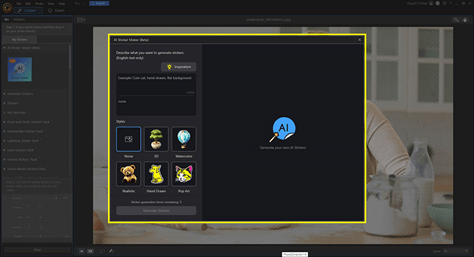
5) Choose a style and type what you want to see.
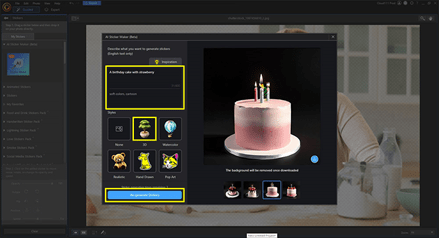
6) Create stickers with PhotoDirector and download the ones you like.
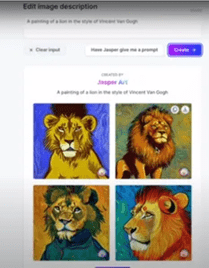
The AI image generator from the photo known as Jasper Art was made by the same people who made the popular AI tool Jasper. With the help of this application, you can create images for your marketing content that reflect various artistic styles and moods using AI image-generation prompts.
First, type in a brief prompt and change the inspiration, mood, and medium parameters. To create art, click. There will be an image produced.
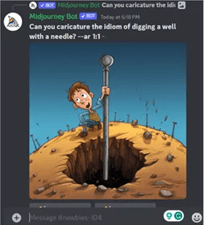
San Francisco-based Midjourney Inc. is an independent research lab that developed and hosts the AI program and service known as Midjourney. Like Open AI's DALL-E and Stable Diffusion, this AI image generator generates images using natural language descriptions or "prompts."
With Midjourney, users can use succinct text descriptions to create unique worlds, characters, and images. A Discord account is needed to use the service, and the quality of the input prompts determines how well the generated images turn out.
Choose Midjourney for stunning images. The outcomes are astounding. The results are frequently so excellent that they can't be separated from artificial art. There have been some award wins!
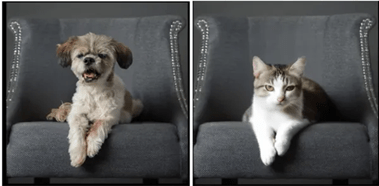
Released in April 2022, DALL-E 2 is an AI image generator from photos and the sequel to Dall-E developed by Open AI. When the tool receives text prompts, it generates realistic images. Thanks to an intriguing feature called Outpainting, it can zoom a photo beyond its original dimensions, allowing it to create more comprehensive pictures in various styles. When instructed, it can also replace items in a snap.

It's among the top text-to-picture AI image generators out there. Compared to other image generator tools, it has a unique granular tool that produces more customized images.
Two output sections are available: Orion (fiction) and Altair (abstractness). There are several options available for setting the background and image style.
Misconceptions about AI-generated art are prevalent. Some of these misconceptions include the belief that AI images lack originality. While they may draw from existing data, AI-generated photos can be entirely novel and distinct.
Another misconception is that AI needs more creativity in producing art. This perception stems from its reliance on training data, which can sometimes lead to predictable results. However, AI has the potential for creativity and can produce innovative and unexpected pieces.
There's a notion that AI art lacks value, but its worth is subjective and depends on the buyer's preferences. While some may question its value due to the absence of human touch, others appreciate AI art for its uniqueness and forward-thinking nature.
It's crucial to remember that AI-generated art is a burgeoning field. With ongoing advancements in AI technology, we can expect AI-generated images to continue evolving in originality, creativity, value, and personal touch.
Here are the top four tips for creating AI images from a photo:
Select High-Quality Source Images: Begin with clear, high-resolution images. The quality of the source photo significantly impacts the final output. Higher-resolution images provide more detail for the AI model to work with, resulting in a better-generated picture.
Experiment with Different Models:Different AI models and algorithms produce varying results. Experiment with different models to find the one best suits your desired outcome. Some models may excel at realistic rendering, while others lean towards stylized or abstract interpretations.
Adjust Style and Parameters: Most AI image generation tools allow you to tweak parameters and styles. Explore these options to fine-tune the output. Adjust brightness, contrast, and saturation or different techniques to achieve the desired effect.
Provide Clear Instructions: If the tool allows for user input or guidance, be specific in your instructions. Communicate what you want the AI to focus on or the style you'd like to be applied. This can help the AI produce an image that aligns with your vision.
Remember, generating AI images is an iterative and creative process. Experimentation, patience, and understanding the capabilities and limitations of your AI model are crucial to achieving the desired results.
In conclusion, creating AI images from photos is a fascinating and evolving process that blends human creativity with advanced artificial intelligence algorithms.
In essence, creating AI images from photos is a dynamic and creative process involving a blend of artistic vision, technical expertise, and an understanding of the AI model's capabilities and limitations. With continued advancements in AI technology, the potential for creating stunning and imaginative AI-generated images is boundless.